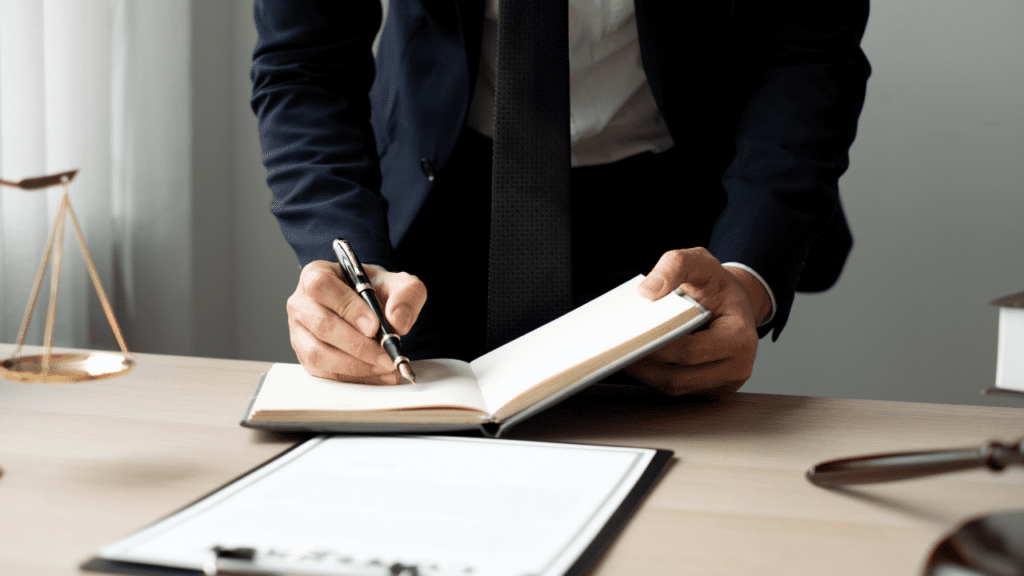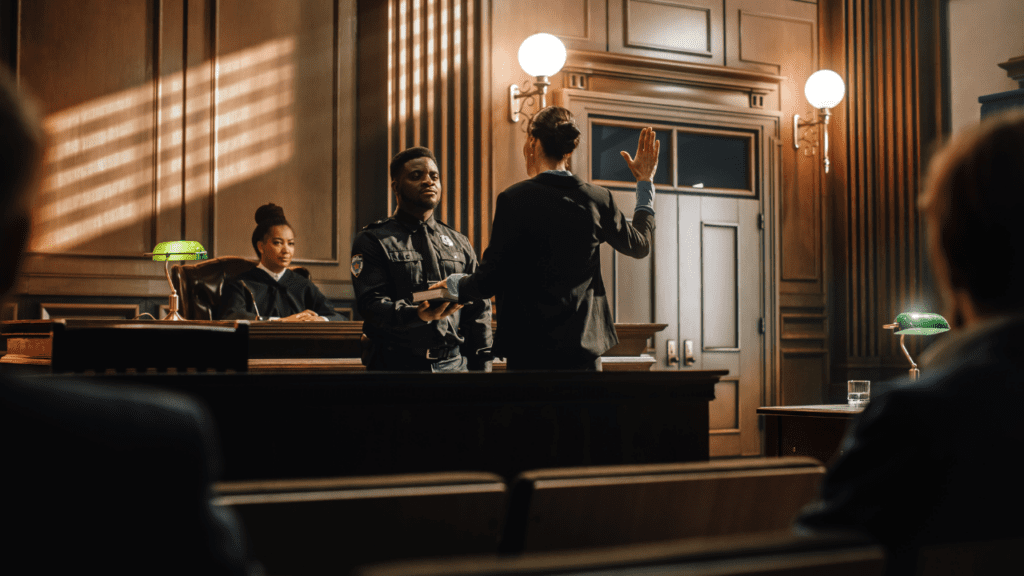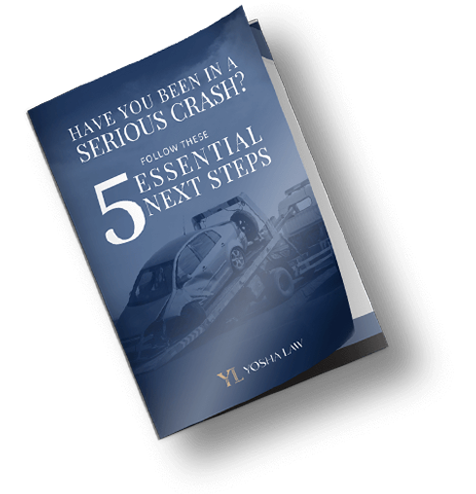After an accident, it can feel like you are suddenly expected to know all kinds of things about the legal system. You may be researching attorneys or lawsuits, only to find a bunch of complicated legal concepts, like liability, tort, mediation, arbitration, statute of limitations, precedent, contingency fee, compensatory damages, and more.
You shouldn’t have to become a legal expert to get through the aftermath of your accident. Instead, you can trust an attorney to be the expert so you can focus on healing.
One of the things a personal injury attorney can do for you is to help you collect evidence that will support your case in your personal injury claim. Let’s take a look at the role of evidence in a lawsuit after an accident. With this information, you can be more prepared for your claim.

- What counts as evidence in a personal injury claim?
- 9 Types of Evidence & How They Affect Your Claim
- Personal Injury Claim Evidence FAQs
- Contact Yosha Law Firm for a Free Case Consultation
What counts as evidence in a personal injury claim?
In a personal injury claim, evidence typically includes any relevant documents, such as medical records, accident reports, and insurance correspondence. Additionally, photographs or videos of the accident scene, witness statements, expert opinions, and any tangible items related to the incident may be presented as evidence. Testimonies from witnesses, including the injured party and any involved parties, contribute to the overall evidentiary support.
9 Types of Evidence & How They Affect Your Claim
There isn’t just one single way that evidence affects a personal injury claim.
The strength of the evidence plays a crucial role in establishing the facts of the case and determining liability, causation, and the extent of damages. Let’s take a look at 9 of the ways that evidence will impact your personal injury lawsuit.
Evidence that establishes liability
Evidence is used to establish who was at fault for the accident that resulted in your personal injury. In a car accident, liability may be assigned to another driver, a municipality who failed to maintain safe roads, or even a car manufacturer for providing a faulty product.
In other accidents, like a slip-and-fall, evidence may prove that a property owner or maintenance company was responsible.
Evidence that proves liability may include eyewitness testimonies, expert opinions, photos and videos, police reports, and accident reconstruction reports.
Evidence that proves damages
The injured party must demonstrate the extent of their injuries and the resulting damages in order to collect compensation for those monetary and non-monetary losses.
There are several things that can prove the extent of your physical and psychological injuries, including medical records, hospital and medical bills, expert medical testimonies, and photographic or video evidence.
The stronger your evidence, the more effectively you will be able to demonstrate the nature and severity of your injuries.
Evidence that proves causation
One of the requirements of a personal injury lawsuit is causation: you have to prove that there was a direct link between the defendant’s actions and the plaintiff’s injuries. This may involve medical records, expert testimony, evidence from the scene of the incident, and eyewitness testimonies.
For instance, in a personal injury claim arising from a car accident, evidence demonstrating causation might include medical records indicating specific injuries sustained in the collision, along with expert testimony linking those injuries directly to the impact.
Additionally, accident reconstruction reports, photographs, or video footage capturing the sequence of events leading to the injuries can help establish a causal connection between the defendant’s actions and the harm suffered by the plaintiff.
The important thing is that the evidence supports your argument that the injuries resulted directly from the defendant’s negligence or wrongful conduct.
Witness testimonies
Eyewitness accounts and testimonies from individuals who observed the incident or accident can provide valuable evidence in support of your case.
They can provide important context for understanding what happened leading up to the accident, as well as testimony about how the events unfolded that led to your injuries.
Here’s an example: In a personal injury case stemming from a slip and fall incident in a grocery store, eyewitness testimony could play a crucial role. For instance, if a customer observed a wet floor near the area where the plaintiff fell, they should be able to provide a detailed account of the conditions leading up to the accident.
In that case, their testimony becomes valuable evidence that can help a judge or jury see the direct correlation between the defendant’s actions and your injuries.
Expert testimonies
Your attorney doesn’t have to limit witnesses to people who were on site when the incident or accident occurred. They can also use experts in relevant fields, such as medical experts, accident reconstruction specialists, or vocational rehabilitation professionals, to help the court or jury understand complex issues related to the accident, liability, and damages.
You are not responsible for finding these experts on your own. Rather, your legal team will know where to find and hire experts to testify truthfully before the courts about their area of expertise.
Documentary evidence
Documents, such as medical records, police records, insurance claims, and correspondence, are categorized as “documentary evidence” and are used to support the facts of your case.
Demonstrative evidence
In contrast to documentary evidence, demonstrative evidence includes visual aids, charts, diagrams, models, and videos. These are used to explain complex concepts related to the case or to illustrate the sequence of events leading to your injuries.
Admissible and authentic evidence
All evidence must be determined by the court to be admissible and authentic. The state of Indiana’s Rules of Evidence governs what types of evidence are permissible in court. Both parties may object to any piece of evidence, which triggers additional review.
Inadmissible evidence will not be accepted by the courts. Additionally, an experienced and ethical personal injury attorney would never submit inauthentic evidence to the court,
Cross-examination evidence
When a case goes to trial, the opposing party has the opportunity to cross-examine witnesses and challenge the credibility or reliability of the evidence presented by each side.
This is why it is essential to work with a knowledgeable personal injury attorney who knows how to present strong evidence that meets the state standards for admissibility and authenticity. Your lawyer will also help you collect documentary evidence, prepare demonstrative evidence, and find appropriate witnesses.
Personal Injury Claim Evidence FAQs
Do all personal injury claims go to trial?
No, most personal injury claims are settled before they ever get to court. However, at Yosha Law, we always prepare every case to go to court if necessary.
What should you save as evidence for a case?
The short answer is that you should save everything! However, some examples of items that should be saved include:
- Medical records
- Accident reports
- Photographs or videos of the accident scene
- Witness statements
- Correspondence with insurance companies
- Employment records
- Documentation of property damage
- Bills and receipts related to medical expenses
- Surveillance footage, if available
- Communication records (emails, text messages)
- Police reports
- Safety inspection records (if applicable)
- Maintenance records (if applicable)
- Product information (if relevant to the case)
- Any tangible items related to the incident
- Proof of lost wages or income
- Accident reconstruction reports
- Any relevant contracts or agreements
- Documentation of pre-existing conditions, if applicable
What if both parties were at fault?
Indiana follows the rule of compensatory negligence, which means that each party is held responsible according to the percentage of their fault. As long as you were less than 50% responsible for the accident, you can file a claim against someone who was more than 50% liable.
Your attorney can review the evidence to determine how much fault you share in the accident. They can also provide a rebuttal to the defendant’s attorney, who will likely try to claim your burden of responsibility should be higher than it really is.
The percentage of your responsibility will be deducted from your final compensation award or agreement. For example, if the court finds that you were 30% responsible, then your total award will be reduced by 30%.
Contact Yosha Law Firm for a Free Case Consultation
If you or a loved one has been injured due to someone else’s negligence, don’t navigate the complex legal process alone.
The experienced personal injury attorneys at Yosha Law Firm in Indianapolis are dedicated to protecting your rights and securing the compensation you deserve. Schedule a free, no-obligation consultation today to have our team review the details of your case and discuss your legal options moving forward.
With our expertise and commitment to client satisfaction, you can have confidence in your pursuit of justice. Take the next step toward healing by reaching out to us today.








